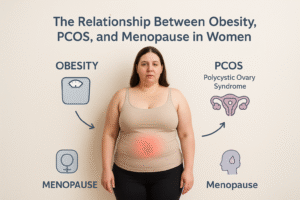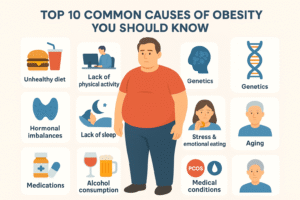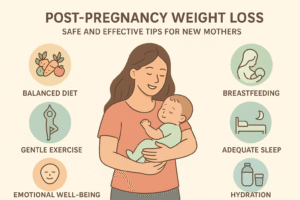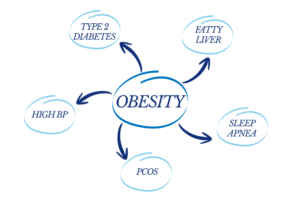Childhood Obesity in India: Why It’s Rising and How to Control It
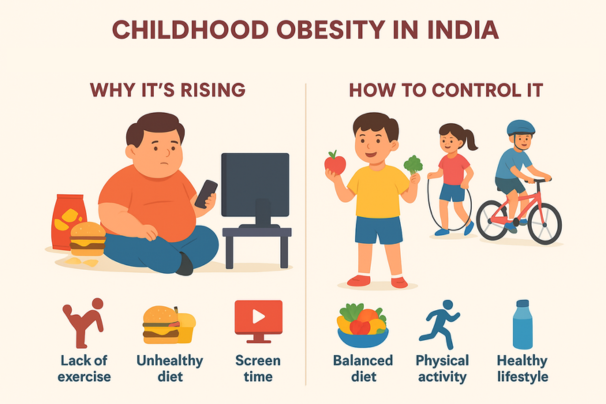
Childhood obesity is emerging as one of India’s most pressing public health challenges. Once seen primarily in developed countries, it is now spreading rapidly across urban and even semi-urban India. According to the Indian Journal of Community Medicine, nearly 14.4 million children in India are obese, making it the second-largest country in terms of childhood obesity cases.
Understanding the causes of obesity in children is crucial to reversing this trend. From poor diets and sedentary lifestyles to socioeconomic changes and lack of awareness, multiple factors are fueling the epidemic. If left unchecked, childhood obesity can lead to early onset of diabetes, heart disease, and lifelong health struggles.
In this detailed blog, we’ll explore:
- Why childhood obesity in India is on the rise
- The key causes of obesity in children
- Long-term risks and complications
- Effective weight loss tips and obesity treatment options
- How families, schools, and healthcare providers can work together
Let’s break down this growing crisis and see how it can be controlled.
Why Childhood Obesity Is Rising in India
Childhood obesity in India is increasing at an alarming rate, with both urbanization and lifestyle modernization playing major roles.
Key factors behind the rise:
- Urban lifestyles: Children in cities have easy access to fast food and limited open spaces for physical activity.
- Dietary shifts: Traditional home-cooked meals are being replaced by processed foods and sugary drinks.
- Technology dependence: Screen time has increased dramatically, reducing outdoor play.
- Socioeconomic growth: With rising income levels, families are spending more on calorie-dense foods.
In short, modernization has improved convenience but has also created an environment where children are more likely to consume excess calories and move less—two of the primary causes of obesity.
Top Causes of Obesity in Indian Children
To address the problem effectively, we must identify the root causes of obesity among children.
1. Unhealthy Dietary Habits
The most direct cause is poor diet. Junk food is easily available, heavily marketed, and often considered “cool” by children.
- Processed snacks like chips, instant noodles, and biscuits dominate school lunchboxes.
- Sugary drinks such as colas and packaged juices are consumed more than milk or water.
- High-calorie fast foods like burgers and pizzas are increasingly replacing traditional meals.
Weight loss tips for children:
- Encourage whole foods like fruits, vegetables, and whole grains.
- Replace sugary drinks with water or buttermilk.
- Limit fast food to once a week as a treat, not a routine.
2. Sedentary Lifestyle and Screen Addiction
Screens than on playgrounds.
- Average screen time for Indian children is over 3–4 hours daily.
- Online classes during the pandemic worsened inactivity levels.
- Lack of open spaces in cities discourages outdoor activities.
Solutions:
- Limit recreational screen time to 1–2 hours per day.
- Promote outdoor play, cycling, or sports.
- Involve families in group activities like walking or yoga.
3. Genetic and Family Influence
Obesity often runs in families. If parents are overweight, children are more likely to adopt similar eating and lifestyle habits.
- Genetics affect metabolism, fat storage, and appetite.
- Family traditions around food (fried foods, sweets) can reinforce unhealthy eating.
- Sedentary parents rarely encourage children to exercise.
Weight loss management tip: Make family-oriented changes—cook healthy meals together, take family walks, and avoid stocking unhealthy snacks at home.
4. Socioeconomic and Environmental Changes
India’s rapid economic growth has altered eating patterns. With greater disposable income, families are spending more on outside food.
- Urbanization means children walk less, use school buses, and rarely cycle.
- Marketing influence: Junk food ads target children directly.
- School cafeterias: Often stocked with unhealthy options.
This “obesogenic environment” is a powerful contributor to the rising rates of childhood obesity.
5. Lack of Awareness Among Parents and Schools
Perhaps one of the most preventable causes of obesity is lack of education around nutrition.
- Many parents equate a “chubby child” with good health.
- Schools often prioritize academics over physical activity.
- Nutrition education is missing in most curriculums.
Solution: Parental and school awareness campaigns about balanced diets, portion control, and physical activity can make a big difference.
6. Emotional Eating and Stress
Even children are not immune to emotional eating. Stress from academics, peer pressure, or family issues can lead to overeating.
- Stress raises cortisol, promoting fat storage.
- Comfort foods are usually high in sugar and fat.
- Academic pressure often replaces outdoor play with long study hours.
Tips: Teach children coping mechanisms like journaling, art, or talking about emotions rather than turning to food.

Health Risks of Childhood Obesity
Childhood obesity is not just a cosmetic issue—it leads to severe health complications, some appearing even before adulthood.
Short-term risks:
- Breathing problems such as sleep apnea
- Early onset of type 2 diabetes
- Joint pain and reduced mobility
- Low self-esteem and bullying in schools
Long-term risks:
- High blood pressure and heart disease
- Chronic diabetes
- Risk of certain cancers
- Greater likelihood of adult obesity
These risks highlight why tackling the causes of obesity early is critical.
Obesity Treatment for Children in India
While prevention is key, many children already struggling with obesity require structured obesity treatment.
1. Lifestyle and Dietary Changes
- Focus on family meals instead of eating out.
- Introduce portion control through smaller plates.
- Avoid strict crash diets—children need nutrients for growth.
2. School-Based Interventions
- Mandatory physical education classes.
- Healthier canteen menus with fruits and whole grains.
- Awareness programs for students and parents.
3. Medical Support
In cases of severe obesity, doctors may recommend:
- Nutritional counseling
- Behavioral therapy for emotional eating
- Medications in rare cases (under strict supervision)
4. Bariatric Surgery for Adolescents
While rare, bariatric surgery is an option for severely obese adolescents with life-threatening conditions. It’s performed only when lifestyle and medical treatments fail.
Effective Weight Loss Tips for Children
- Promote fun activities: Dancing, swimming, cycling—make exercise enjoyable.
- Involve children in cooking: They’re more likely to eat healthy food they helped prepare.
- Plan meals together: Involve kids in grocery shopping and meal planning.
- Keep healthy snacks at eye level: Fruit bowls, yogurt, or nuts.
- Set realistic goals: Small changes like replacing one soda a day can make a big difference.
Remember: Weight loss management for children should focus on healthy growth, not just calorie restriction.
How Families and Communities Can Help
Childhood obesity is not just a medical issue—it’s a societal one. Everyone has a role to play.
- Parents: Role models for eating and activity habits.
- Schools: Provide nutrition education and physical activity.
- Healthcare providers: Early screening and guidance.
- Government: Policies to regulate junk food advertising to children.
FAQs About Childhood Obesity and Causes of Obesity
Q1. What are the main causes of obesity in Indian children?
The main causes of obesity include poor diet, sedentary lifestyle, genetics, environmental changes, emotional eating, and lack of awareness among parents.
Q2. Can childhood obesity be treated without surgery?
Yes. Most cases are treated with lifestyle changes, healthy diets, increased activity, and behavioral support. Surgery is considered only in severe cases.
Q3. What role does school play in controlling obesity?
Schools can reduce childhood obesity by ensuring daily physical activity, healthy canteen menus, and nutrition education programs.
Q4. Is bariatric surgery safe for children?
Bariatric surgery is only recommended for severely obese adolescents under strict medical supervision when other treatments fail.
Q5. How can parents prevent obesity in children?
By encouraging balanced meals, limiting screen time, promoting outdoor play, and setting a healthy example at home.
Q6. Are the causes of obesity the same for adults and children?
Some causes overlap—like poor diet and inactivity—but in children, factors such as parental influence, school environment, and growth patterns play a bigger role.
Conclusion
Childhood obesity in India is a growing epidemic that threatens the health of an entire generation. The root causes of obesity—unhealthy diets, sedentary lifestyles, genetic predispositions, and lack of awareness—are preventable if addressed early.
Through obesity treatment, awareness programs, family involvement, and school-based initiatives, India can reverse this trend. For severe cases, medical guidance and even bariatric surgery may be necessary.
Ultimately, the solution lies in a collective effort—families, schools, healthcare providers, and policymakers working together. By tackling the causes of obesity head-on, we can ensure that children grow up healthy, active, and ready for a better future.


